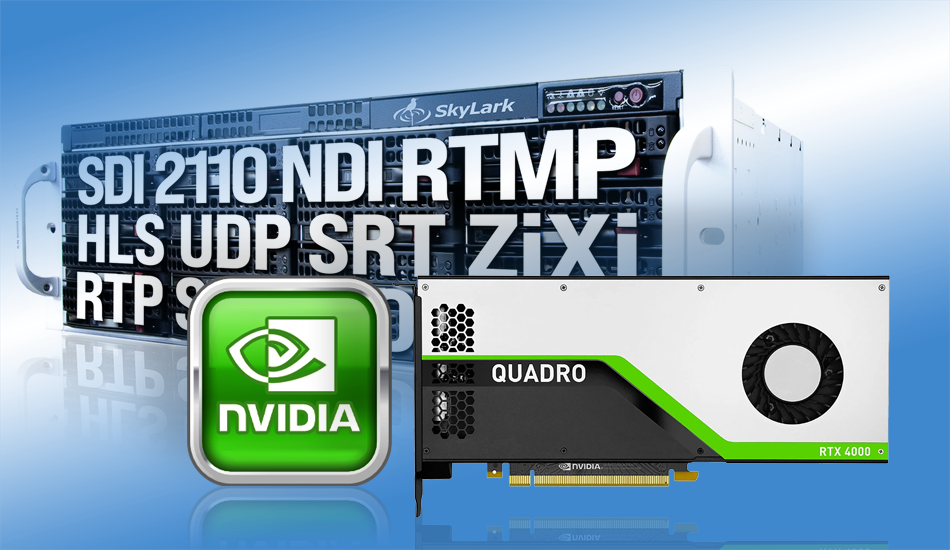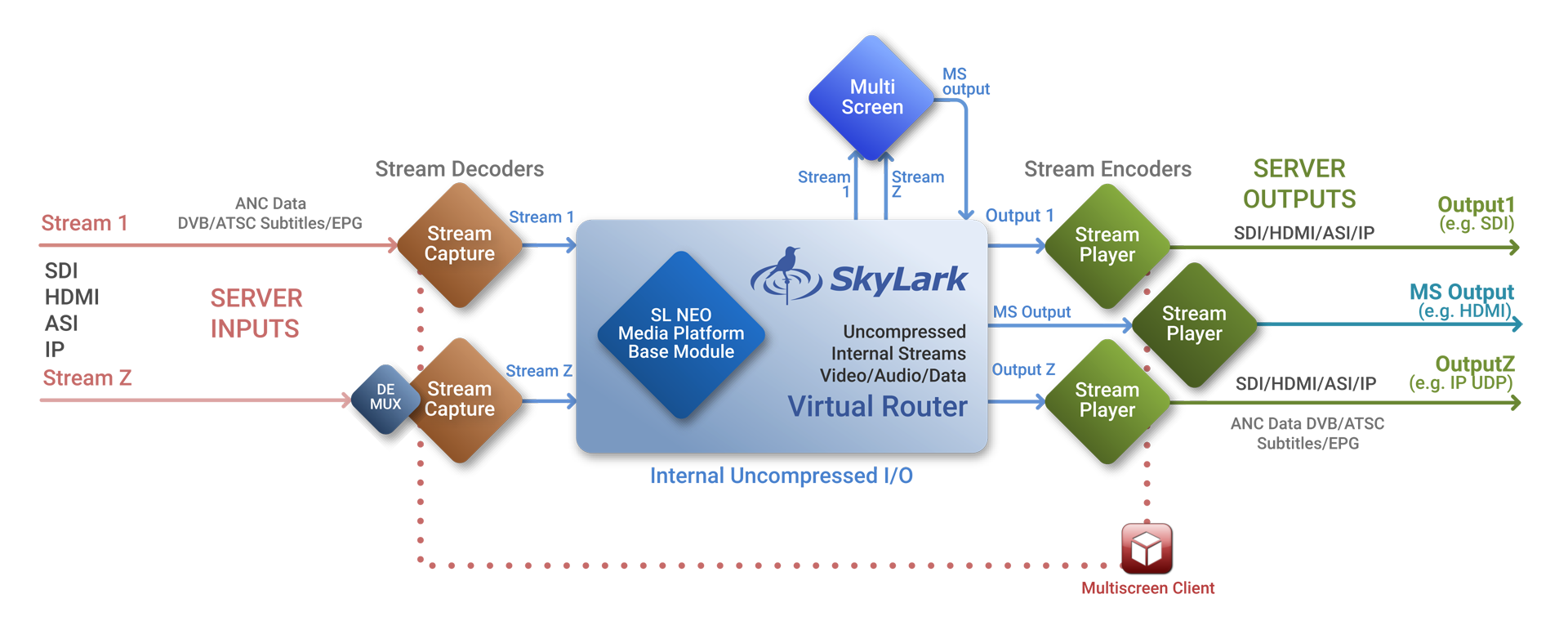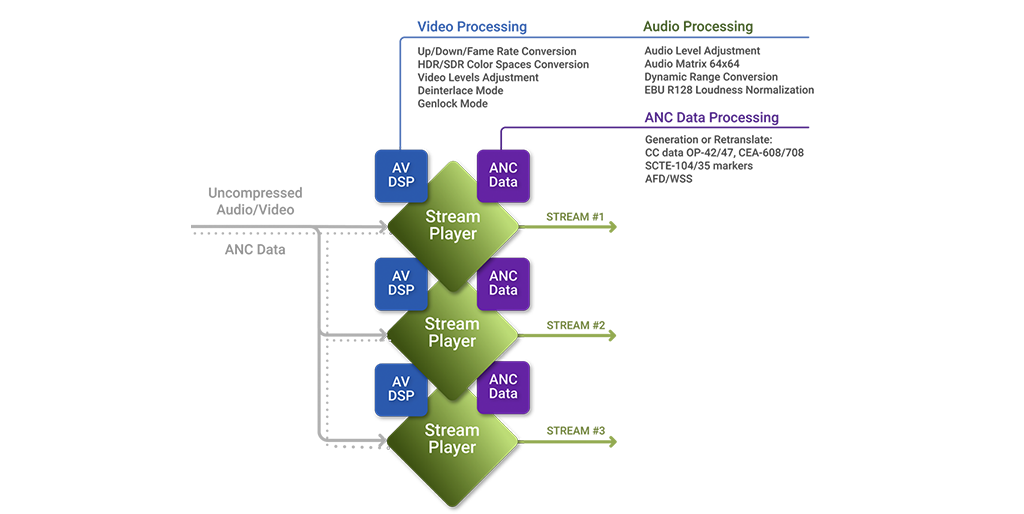Base SL NEO Software Modules
Modules interaction diagram for Capture and Decoding, Video/Audio and Data Processing, subsequent Encoding and Data Embedding
Supported Interfaces, Protocols and Data Formats
Capture
- Demux, decoding of incoming Signals/Streams with embedded data (SCTE Markers, Closed Captions, Timecode, etc.) from SDI/HDMI Boards, ASI/IP Interfaces to Uncompressed audio/video realtime streams.
 Functional diagram of a single-channel Stream Capture module
Functional diagram of a single-channel Stream Capture module
Encoding using GPU or CPU
- NVIDIA Quadro P2000: 1080p50*6 streams, 1080i50*12 streams,
- NVIDIA Quadro RTX 4000: 1080p50*8 streams.
Out Channel UHD SkyLark Additional UHD SDI / IP (SPTS/RTMP/NDI) output = 12 virtual cores (threads).

Audio, Video and Data Processing
- Up/Down/Cross Convertion (change Resolution, FPS, Color Spaces),
- Video Levels Ajust, Super White/Black Modes,
- Audio Channel Mapping (matrix 64×64),
- Output Loudness Normalization (EBU R-128),
- Audio Levels Ajust and Normalization, Audio Dynamic Range Compression,
- ANC/MPEG2 Data Multiplexing: VITC, AFD/WSS, DTMF, Closed Captions, SCTE-104/SCTE-35, DVB/ATSC Subtitles, EPG.
Diagram of Processing & Encoding operations. Multibitrate is provided by a certain number of Stream Player modules
IP Protocols for Production
SMPTE ST 2110
ST 2110 is a suite of standards from the Society of Motion Picture and Television Engineers (SMPTE) that describes how to send digital media over an IP network. ST 2110 is intended to be used within broadcast production and distribution facilities where quality and flexibility are more important than bandwidth efficiency.
NDI (Network Device Interface)
NDI is an open protocol, a standard that allows multiple video systems to identify each other and communicate over an IP connection to encode, convert and receive high quality streaming video and audio data with minimal delay. Many see it as an easier and cheaper route to IP-based operations than the expensive SMPTE standards. The protocol allows remote device control in addition to video, audio, and service information. Supports a wide range of video devices, such as video mixers, PTZ cameras.
IP Protocols for Streaming
HLS (HTTP Live Streaming)
HLS is an adaptive HTTP-based streaming protocol that sends video and audio over the network to small TCP-based streaming media segments that are reassembled at the destination. HLS was originally developed by Apple Inc. as a protocol for streaming media to Apple devices. HLS currently supports video encoded using H.264 or HEVC codecs.
MPEG-DASH (Dynamic Adaptive Streaming over HTTP)
MPEG-DASH is an open standard HTTP-based adaptive streaming protocol that sends video and audio content over a network in small segments of TCP-based streaming media that are reassembled at the destination. MPEG-DASH functions in much the same way as HLS, operating on a «quality over latency» principle, so latency times can be high.
RTMP (Real-Time Messaging Protocol)
RTMP is a well established and proven streaming protocol. Although RTMP is by far still the most popular streaming protocol, SRT, HLS and MPEG-DASH are challenging it.
UDP (User Datagram Protocol)
The User Datagram Protocol (UDP) is one of the main communication protocols. It has no handshake dialogs and thus exposes the user to any unreliability of the base network. Time-sensitive applications often use UDP because dropping packets is preferable to waiting for packets delayed due to retransmission, which may not be possible in a real-time system.
SRT (Secure Reliable Transport)
SRT provides high quality video and audio transmission over the Internet with low latency, provides firewall traversal between source and destination. SRT uses its own recovery method after packet loss, using UDP packets. When network conditions are poor, buffer sizes can be increased to improve video quality. As network conditions improve, the amount of delay can be reduced.
ZiXi
ZiXi is UDP-based, video-optimized protocols on standard IP networks, including the public Internet. ZiXi dynamically adapts to changing network conditions and uses error correction methods to deliver error-free video streaming over IP. At minimal physical bandwidth cost, this dynamic mechanism provides low end-to-end latency, removes jitter, recovers and reorders packets, smooths video delivery, and recovers video in its original form in real time.
RIST (Reliable Internet Stream Transport)
RIST is an open-source, open-specification transport protocol designed for reliable transmission of video over lossy networks (including the Internet) with low latency and high quality. RIST is intended as a more reliable successor to SRT, and as an open alternative to proprietary commercial options such as Zixi, VideoFlow, QVidium, and DVEO (Dozer).


